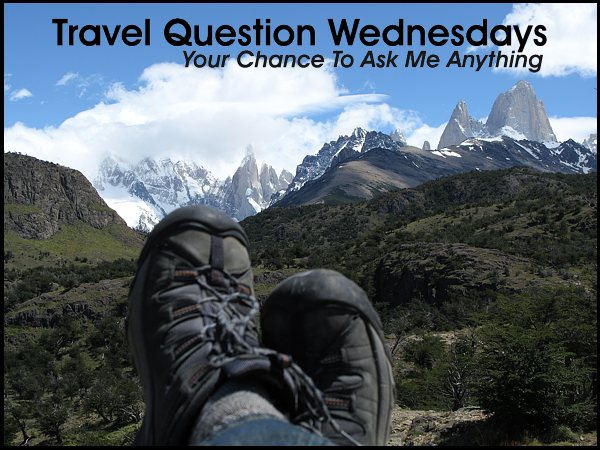This post is part of the Ask Alex, Travel Question Wednesdays weekly series. To see previous questions click here. To submit your own; tweet it to @AlexBerger, ask it in a comment on this post or send it in by e-mail.
This week’s travel question is from Stella H. she asks,
Q. “Most of your packing and financing tips seem to be for 2 week trips, which makes sense because thats generally the most time people can afford to take off. How do you find that these things change for longer trips?”
A. – Very true! While the majority of my travel has been in 16-20 day bursts the longest trip I’ve enjoyed in the last few years was a three month adventure that stretched from Scotland in September, to southern Greece in December. As noted in your e-mail, weather across a variety of different climates on a longer trip can be a significant challenge. These difficulties can also be found on shorter trips that hop hemispheres or cover large distances over short periods of time such as my Argentina trip which went from topical jungles to glaciers over the course of 21 days. From the experiences garnered during these trips, my discussions with ultra-long term travelers, and research into advice from veteran RTW (round-the-world) backpackers I suggest the following:
To start with map out the approximate route you will be taking while paying close attention to the time of year you’ll be visiting, altitude and latitude. Packing for an extended duration trip which has fairly distinct and non-repeating climate conditions is very different from a trip that will regularly alternate between hot climates and cold climates. If your itinerary is split between warm climates and cold climates, it is probably beneficial for you to pack predominantly for the first climate you’ll be encountering, and then set aside an additional budget to purchase the items you need for the second climate when your trip reaches that phase. Similarly, keep in mind what warm (or cold) weather items you are willing to discard or mail home when they are no longer needed. It’s common sense, but I find often forgotten (by everyone, including me) that clothing will likely be approximately the same price, if not cheaper in the destinations you’ll be visiting.
On the other hand, if you’ve planned a long-term trip that will be bouncing between hot and cold climates you’ll need to take a different approach, as the discard/purchase route is not economical or time efficient. In these cases I suggest focusing heavily on clothing that can be layered easily. Leave the Hawaiian shirts at home, and instead opt for clothing that is flexible and works well as a stand alone, or as a sub-layer. For me, this meant layering a t-shirt, long sleeve shirt, north face windproof vest, large scarf, and waterproof rain jacket with gloves for my trip to Argentina with silk underwear as a backup just-in-case. In the warmer parts of Argentina I stashed the layers and opted for a pair of jeans and t-shirt/swimsuit in the more tropical climates. Remember that a warm scarf, good gloves, and hat go a long way towards keeping you warm. I have also been told a good pair of tights is an absolute must for women. You’ll find that by following this approach, and avoiding absolutely extreme climates (eg: Northern Norway in winter), you’ll be in good shape pretty much anywhere you go.
When preparing for your trip, I encourage you to categorize the items you’re considering purchasing/taking with you into one of two categories. The first should be high cost items that also need to be good quality and have an expensive replacement cost. This list should be fairly short and will likely consist of little more than your backpack, your shoes, and your jacket. The second category should consist of more general day-in-day-out items: things like t-shirts, socks, a cheap sweater and underwear. Items in the first category are the types of things you typically want to purchase ahead of time and which you don’t mind hauling everywhere with you. Items in the second category can be replaced or supplemented fairly easily on the road and tend to have a fairly low replacement cost. For example, if you absolutely must have that Hawaiian shirt for the beach part of your trip, pick it up when you arrive at the beach and then discard it when you head on to a colder climate. Remember, a $12 t-shirt that you use for 1/4th of your trip isn’t worth hauling all over the world with you.
Lastly, people are often tempted to ship a drop package ahead with warm/cold weather gear (as is applicable) for the second or third leg of their trip. While this is certainly doable and a must for some travelers, I would suggest against it in most cases. Not only is there a significant cost associated with shipping things across continents – a cost that may ultimately be more than the simple replacement cost for the items being transported – there is also a headache and convenience element as you wait for delayed packages to arrive, deal with damaged or stolen packages, or try and find a location that is willing to receive the mailed items and hold them until your arrival.
If you review the packing videos that I’ve posted you’ll note that I tend not to change the basics much regardless of the climate i’m visiting. While most of the videos are tailored towards shorter trips my list for a multi-month budget adventure would not change significantly. For additional insights you can see the analysis of what I took for my three month trip back in 2007 here.
Would you like me to elaborate on an aspect of this response? Let me know!
Have a question of your own? ASK IT! Want to see previous questions? click here.
